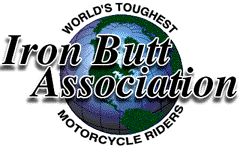 Please respect our intellectual property rights. Do not distribute
any of these documents, or portions therein, without the written
permission of the Iron Butt Association or the author,
Robert Higdon.
Please respect our intellectual property rights. Do not distribute
any of these documents, or portions therein, without the written
permission of the Iron Butt Association or the author,
Robert Higdon.
It's Paris-Dakar Rally time again, the mostly annual romp from north-central France to Dakar, Senegal via Spain, Morocco, Mauritania, and other exotic places. Geography fans will note that the straight-line distance requires riding through a significant hunk of a rather large desert. It is not something for the faint of heart. It's also not something that is always spectator-friendly. The public relations boys for the rally tend to cancel the event when they have to bury too many innocent bystanders from the year before. Last year must have been relatively quiet, for before dawn on New Year's Day, 349 vehicles --- 173 motorcycles, 115 cars, and 61 trucks --- were warming up in Versailles, France.
Sure, they call it a rally, but believe me, in large sections of this event it is nothing but a flat out race. The course is divided into transit zones (called "liaisons") and stages (called "stages"). The purpose of the transit zone is to allow entrants to travel from one stage to another along public roads, generally at a velocity approximating the local speed limit. When you reach the end of a transit zone, you begin a stage at an assigned time. When you've completed the stage, you're either through for the day or you begin another quiet transit zone. It's not rocket psychiatry. The only requirement is that you must be on time to begin your stage. If you can read a watch, you should be in good shape. When they drop the flag that signals the start of your stage, you take off.
And God, how you will take off. Here again, the problem is not a subtle one. Stages vary wildly in the distances that they cover, but they share one common trait: the time that you are given to complete the stage, no matter how long it may be, is zero seconds. Few vehicles, even the frightening super-production KTMs that are expected to dominate the bike class of the rally, can travel at the speed of light. You will thus incur penalty points --- one per second --- that you are late at the end of the stage. After eighteen days, the fewest penalty points will win. Simple, huh?
The organizers took it easy on the field today. It was a 938 km tour from Versailles, through Paris, south down the spine of central France, and concluding at Narbonne near the border with Spain. There was just one stage, an 11 km section of dirt. No problem. Well, almost no problem. It was bitterly cold and the dirt wasn't dirt any longer. It was mud, cold mud, and there was a lot of it. But the neat thing about the Paris-Dakar is that no matter how ugly it gets, someone will get through there in the least amount of time. And today belonged to local amateur Francois Flick.
Frankie couldn't have been looking forward to this. His bike, a Honda XR400, was an infantile joke compared to the brooding factory KTMs that could flatten him and never notice. But Frankie had a few things going for him: he was a Frenchman, there were nearly seventy thousand Frenchmen screaming his name at the start of the stage, and his bike weighed next to nothing. Allez! Frankie, they yelled.
And allez Frankie did, cutting through the 6.84 miles of slime at about 43 mph. Normally that would have gotten him a finishing position of about 167th in the field, but this was not a normal day. The mud got worse. Then it got horrible. Then it became impassable. Halfway through the lineup, the organizers stopped the carnage. They gave median scores to contestants who were prevented from completing the stage. You'll never hear Francois Flick's name again in the Paris-Dakar this year unless he kills himself or someone else, but his time held up. Not only that, his tiny little production bike, a class just a step above a skateboard, was nearly a minute ahead of the fastest super-production entry with any realistic chance of winning.
Flick's finish was a bonne New Year's present for the French, but it soon got more bonne: nearly half of the top twenty riders were their fellow countrymen. On top of that, the hated boys from Berlin were in the toilet. The two top riders on Richard Schalber's F650 BMW team, Italian Edi Orioli and Spaniard Oscar Gallardo, were stuck in 47th and 52nd place respectively. Yeah, Frenchman Jean Brucy was also on Schalber's rotten Deutsch team, but Brucy had ridden out of his skull, ending the day in eighth place, and a repeat of that performance was not expected. He was clearly a mudder. Andrea Mayer, the sole distaff member riding for Schalber, was a distant 93rd, a mudder not.
Day #2 will send them across the mountains to Spain, a long (1182 km) day with a short (35 km) stage. And, the glowing French hoped, maybe the warmer weather would wake up The Man. He's France's own Stephane Peterhansel, fifteenth overall on the first day aboard a Yamaha 850 XTZ, and the toughest rider the rally has ever seen. He has knocked the Paris-Dakar to its knees five times. The rider's entry plate is a fair estimate of potential success on the rally. Peterhansel carries plate #1.
And he just loves Africa. Robert Higdon
© 1998 Iron Butt Association, Chicago, Illinois
Please respect our intellectual property rights. Do not distribute any of these documents, or portions therein, without the written permission of the Iron Butt Association.